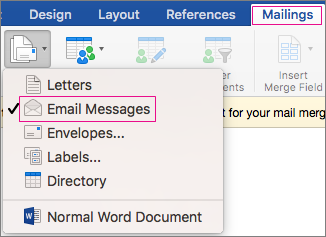

- Do a mail merge in word for mac 2011 how to#
- Do a mail merge in word for mac 2011 mac os x#
- Do a mail merge in word for mac 2011 full#
Then click on Outlook and select Work Offline.

Since we're using a Gmail account as an example, you would click Other Email.Įnter the appropriate information, and then click Add Account. Launch up Outlook and select Outlook > Preferences.Īdd whatever account you plan on emailing from. Under Forwarding and POP/IMAP, make sure Enable IMAP is selected (you may have to scroll down a bit to see the option).įor some reason, Google doesn't consider Outlook to be secure, so in order to access Google from Outlook, you'll have to go to /settings/security/lesssecureapps and select Turn on. So, with Gmail as an example, go to Settings. I'm using Gmail as an example, but you can do an email merge with any kind of email account, as long as it can be put into Outlook (Exchange, POP, IMAP, etc.).Īlso, please be mindful, since you don't really have an unsubscribe button in Outlook email merges, that you should still be complying with the CAN-SPAM Act guide.
Do a mail merge in word for mac 2011 how to#
This blog post is really about how to do an email merge using Microsoft Office on a Mac, so here are the steps and considerations. Microsoft Office (Excel, Word, Outlook) Email Merge
Do a mail merge in word for mac 2011 mac os x#
This Apple support communities discussion has some interesting other workarounds in Mac OS X for doing an email merge, including using the Mail Merge add-on for Thunderbird. If you don't mind the developers having access to your Google information, then you may want to explore these options: There are also some third-party add-on solutions. Here are some examples of those SaaS solutions: For example, if you don’t want the Address Block to include a Title, click the drop-down arrow and choose “(not matched)” from the list of fields.If you're an organization doing a lot of targeted mailings and campaigns, you may want to consider uploading your email lists to an online service that will track campaigns and templates for you as well as give your users an easy way to unsubscribe. The Match Field dialog box can also be used to remove unneeded fields. When all of the fields have been matched, click OK. The remaining fields can be matched the same way. Excel now knows to use the Name-First field in place of First Name. For example: Click the drop-down arrow next to First Name. Choose the correct field name from the list. To match the required field with our field names, click the drop-down arrow to the right. Notice that the First Name, Last Name, Address 1, and State fields are not matched. On the left of the dialog box is a list of fields required for all special fields. We can correct this by matching our field names with the fields used in the Address Block.įrom the Insert Address Block dialog box or the Write & Insert Fields group on the Ribbon, click Match Fields. When we attempt to use the Address Block feature, our results look like this: Several fields, Name-Last, Name-First, Addr, and ST, do not use the correct field names. This is an example of a data source in Excel that does NOT use the correct field names: If this happens, you can tell Word exactly which fields should be used and where they should be placed.

In these cases, the Address Block and Greeting Line features may not work as expected. However, you may have a data source which uses different field names. In a perfect world, everyone would be aware of, and follow, these naming conventions. However, “Zip” is recognized for “Zip Code.”
Do a mail merge in word for mac 2011 full#
Use the full words “Address,” “City,” and “State.” Abbreviations of these words are not recognized by Word.The same varieties apply to the Last Name field. For the Name fields, you may use either “First Name,” “FName,” or even simply “First” to cause Word to recognize that the data in the field is associated with a first name.When using the Address Block or Greeting Line features of Mail Merge, the fields have to be specific.


 0 kommentar(er)
0 kommentar(er)
